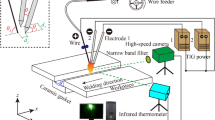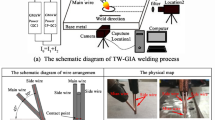Abstract
A twin-electrode TIG-MIG (T-TIG-MIG) indirect arc welding method was proposed in this paper. The arc behavior and droplet transfer process were preliminarily investigated; moreover, the process stability was assessed, and bead-on-plate welding was conducted. Results showed T-TIG-MIG indirect arc burnt between a wire and two tungsten electrodes and was essentially formed by the coupling of two single-electrode TIG-MIG indirect arcs. The wire feeding speed (WFS) determined the equilibrium position of the wire end, and the vicinity of the tungsten tips was an ideal position for arc shape and droplet detachment, where the arc was more concentrated with a higher coupling degree. With the increase of the welding current, the arc length and stiffness increased gradually; so did the process stability and the spreadability of the weld bead. When the current exceeded the critical current, the droplet transfer mode changed into streaming spray transfer, since the electromagnetic force and the arc pressure increased considerably. Compared to conventional cold-wire T-TIG welding under the same current, the wire deposition rate of T-TIG-MIG indirect arc welding increased by about 186%, while the range of the heat-affected zone reduced by about 41%.
















Similar content being viewed by others
Data availability
All the data have been presented in the manuscript.
References
Zhang Y, Yang Y, Zhang W, Na S (2020) Advanced welding manufacturing: a brief analysis and review of challenges and solutions. J Manuf Sci Eng Trans ASME 142:110816
Wang Z, Jiang D, Wu J, Xu M (2020) A review on high-frequency pulsed arc welding. J Manuf Process 60:503–519
Zou S, Wang Z, Hu S, Zhao G, Wang W, Chen Y (2020) Effects of filler wire intervention on gas tungsten arc: Part I - mechanism. Weld J 99:246s–254s
Ungethüm T, Spaniol E, Hertel M, Füssel U (2020) Analysis of metal transfer and weld geometry in hot-wire GTAW with indirect resistive heating. Weld World 64:2109–2117
Lv S, Tian X, Wang H, Yang S (2007) Arc heating hot wire assisted arc welding technique for low resistance welding wire. Sci Technol Weld Join 12:431–435
Voigt AL, Cunha TV, Niño CE (2020) Conception, implementation and evaluation of induction wire heating system applied to hot wire GTAW (IHW-GTAW). J Mater Process Technol 281:116615
Chen J, Lu Y, Li X, Zhang Y (2012) Gas tungsten arc welding using an arcing wire. Weld J 91:261s–269s
Wang J, Wu D, Liao P, Tian C, Li M, Feng J (2013) Metal transfer and arc behaviour of novel consumable and non-consumable electrode indirect arc droplet welding. Sci Technol Weld Join 18:261–270
Kobayashi K, Yamada M, Fujishima K, Iijima T, Ushio M (2004) Development of high efficiency twin-arc TIG welding method. IIW Doc XII: 1669–1701
Leng X, Zhang G, Wu L (2006) The characteristic of twin-electrode TIG coupling arc pressure. J Phys D Appl Phys 39:1120–1126
Leng X, Zhang G, Wu L (2006) Experimental study on improving welding efficiency of twin electrode TIG welding method. Sci Technol Weld Join 11:550–554
Chen S, Wang L, Xiao J, Wei P (2018) Arc behavior and droplet dynamics of AC GTAW-GMAW hybrid indirect arc. Weld J 97:91–98
Ando K, Hasegawa M (1985) The phenomenon of welding arc. China Machine Press, Beijing
Yang M, Yang Z, Qi B (2015) The effect of pulsed frequency on the plasma jet force with ultra high-frequency pulsed arc welding. Weld World 59:875–882
Lu Y, Chen S, Shi Y, Li X, Chen J, Kvidahl L, Zhang Y (2014) Double-electrode arc welding process: principle, variants, control and developments. J Manuf Process 16:93–108
Zhao Y, Chung H (2018) Numerical simulation of the transition of metal transfer from globular to spray mode in gas metal arc welding using phase field method. J Mater Process Technol 251:251–261
Huang J, Pan W, Yang W, Xue C, Shi Y, Fan D (2019) The influence of bypass current on metal transfer in dual-bypass gas metal arc welding. J Manuf Process 38:179–186
Choi JH, Lee J, Yoo CD (2001) Dynamic force balance model for metal transfer analysis in arc welding. J Phys D Appl Phys 34:2658–2664
Kim YS, Eager TW (1993) Analysis of metal transfer in gas metal arc welding. Weld J 72:269s–278s
Huang Y, Shao Y, Zhang Y (2012) Nonlinear modeling of dynamic metal transfer in laser-enhanced GMAW. Weld J 91:140s–148s
Lin ML, Eagar TW (1986) Pressures produced by gas tungsten arcs. Metall Trans B 17:601–607
Funding
This work was supported by the National Natural Science Foundation of China (No. 52175290).
Author information
Authors and Affiliations
Contributions
Yanli Zhu: writing—original draft, methodology, and formal analysis. Zeli Wang: supervision and validation. Runtao Liu: supervision and validation. Liming Liu: conceptualization, writing—review, and editing.
Corresponding author
Ethics declarations
Ethics approval
The paper follows the guidelines of the Committee on Publication Ethics (COPE).
Consent to participate
The authors declare that they all consent to participate in this research.
Consent for publication
The authors declare that they all consent to publish the manuscript.
Competing interests
The authors declare no competing interests.
Additional information
Publisher's Note
Springer Nature remains neutral with regard to jurisdictional claims in published maps and institutional affiliations.
Rights and permissions
About this article
Cite this article
Zhu, Y., Wang, Z., Liu, R. et al. Study on arc behavior and droplet transfer in twin-electrode TIG-MIG indirect arc welding. Int J Adv Manuf Technol 120, 6821–6831 (2022). https://doi.org/10.1007/s00170-022-09131-1
Received:
Accepted:
Published:
Issue Date:
DOI: https://doi.org/10.1007/s00170-022-09131-1




